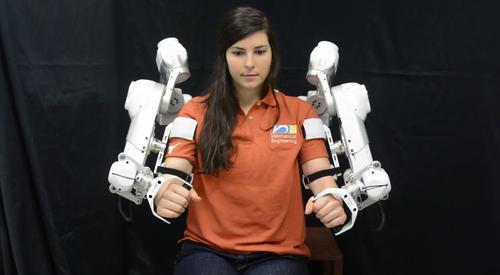Mechatronics Helps Create 'Harmony' in Physical Therapy Robot
November 10, 2015

Physical therapy -- typically done by a human specialist -- may be the next area where robots will take hold in the medtech field thanks to researchers at the University of Texas-Austin.
A group of researchers in the university's Cockrell School of Engineering have developed what they say is a first-of-its-kind, two-armed, robotic rehabilitation exoskeleton called HARMONY that could provide a new method of high-quality, data-driven therapy to patients suffering from spinal and neurological injuries.
HARMONY can deliver full upper-body therapy on patients with limited motion in their arms and shoulders, applying pressure and force as appropriate, researchers said. This allows the robot to feel weightless to patients. The exoskeleton also records data about the patient's movements and ability, giving physicians and caretakers the ability to track and analyze therapy and progress.

Ashish Deshpande, assistant professor of mechanical engineering at UT-Austin, described to Design News the specifics of how HARMONY works in an interview.
"A set of mechanisms are especially designed to be able to power all the shoulder movements of the shoulder joints," he told us. "HARMONY is specially designed to offer customized therapy for optimal efficacy. Not only does the exoskeleton adjust to patient size, it can also be programmed to be gentle or firm based on the individual's therapy needs."
Moreover, HARMONY's design accommodates the entire upper body, setting the robot apart from existing technologies that focus on only one arm and limit bilateral training possibilities, Deshpande added. "It connects to patients at three places on each side of the upper body and features 14 axes for a wide range of natural motion," he said.
Exoskeletons are not a new technology, but they are becoming more complex and are able not only to provide robotic support for patients that have muscular difficulties, but are also able to facilitate movement. They also are becoming more interconnected to applications through computing infrastructure to provide relevant data to a patient's therapy.
All of these elements come together in HARMONY, which wouldn't be possible without mechatronics, a discipline that combines mechanical and electrical engineering as well as other aspects of engineering such as sensing and computing. Mechatronics is becoming the baseline design principle for robotics today, which must combine various elements to meet increasing demand for machine capability.
READ MORE ARTICLES ON MECHATRONICS:
Indeed, HARMONY's design includes novel mechanical elements, novel actuators, state-of-the-art mechatronics, and a suite of sensors that mimic human biomechanics, Deshpande said. And the team isn't finished adding computing elements to the design. "We are working on software controls to achieve a variety of control modes that will deliver subject-specific therapy for fast recovery," he said.
But designing all of these systems and enabling them to work together is not without its challenges, Deshpande acknowledged. He said ensuring that HARMONY moves the patient's body through its natural motions was one of the biggest challenges in its design.
"Incorrect movements from the robot could result in discomfort or even injuries," he said, adding that another challenge the team faced was also movement-related -- making sure the robot provides the correct level of assistance appropriate to the patient. "Some subjects may need a lot of assistance while others may need to be challenged for positive therapy outcomes," Deshpande told us.
He said the team already has been testing HARMONY with healthy subjects. The next step for their research is to continue to develop the robot's software and test it on human subjects that actually need this type of therapy to see how it compares to using human physical therapists.
"We plan to follow it with a study with stroke and spinal cord injury patients that will compare HARMONY's efficacy with conventional rehabilitative therapy," Deshpande said.
Elizabeth Montalbano is a freelance writer who has written about technology and culture for more than 15 years. She has lived and worked as a professional journalist in Phoenix, San Francisco, and New York City. In her free time she enjoys surfing, traveling, music, yoga, and cooking. She currently resides in a village on the southwest coast of Portugal.
Like reading Design News? Then have our content delivered to your inbox every day by registering with DesignNews.com and signing up for Design News Daily plus our other e-newsletters. Register here!

Design News will be in Orlando in November! Design & Manufacturing South will be in Orlando Nov. 18-19. Get up close with the latest design and manufacturing technologies, meet qualified suppliers for your applications, and expand your network. Learn from experts at educational conferences and specialty events. Register today for our premier industry showcase in Orlando.
About the Author(s)
You May Also Like



